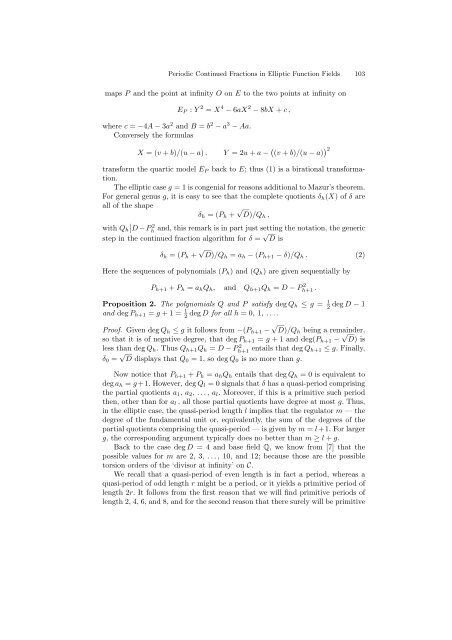Periodic Continued Fractions in Elliptic Function Fields - Macquarie ...
Periodic Continued Fractions in Elliptic Function Fields - Macquarie ...
Periodic Continued Fractions in Elliptic Function Fields - Macquarie ...
Create successful ePaper yourself
Turn your PDF publications into a flip-book with our unique Google optimized e-Paper software.
<strong>Periodic</strong> <strong>Cont<strong>in</strong>ued</strong> <strong>Fractions</strong> <strong>in</strong> <strong>Elliptic</strong> <strong>Function</strong> <strong>Fields</strong> 103<br />
maps P and the po<strong>in</strong>t at <strong>in</strong>f<strong>in</strong>ity O on E to the two po<strong>in</strong>ts at <strong>in</strong>f<strong>in</strong>ity on<br />
EP : Y 2 = X 4 − 6aX 2 − 8bX + c,<br />
where c = −4A − 3a 2 and B = b 2 − a 3 − Aa.<br />
Conversely the formulas<br />
X =(v + b)/(u − a) , Y =2u + a − (v + b)/(u − a) 2<br />
transform the quartic model EP back to E; thus (1) is a birational transformation.<br />
The elliptic case g =1is congenial for reasons additional to Mazur’s theorem.<br />
For general genus g, itiseasy to see that the complete quotients δh(X) ofδ are<br />
all of the shape<br />
δh =(Ph + √ D)/Qh ,<br />
<br />
with QhD<br />
−P 2 h and, this remark is <strong>in</strong> part just sett<strong>in</strong>g the notation, the generic<br />
step <strong>in</strong> the cont<strong>in</strong>ued fraction algorithm for δ = √ D is<br />
δh =(Ph + √ D)/Qh = ah − (Ph+1 − δ)/Qh . (2)<br />
Here the sequences of polynomials (Ph) and (Qh) are given sequentially by<br />
Ph+1 + Ph = ahQh, and Qh+1Qh = D − P 2 h+1 .<br />
Proposition 2. The polynomials Q and P satisfy deg Qh ≤ g = 1<br />
2 deg D − 1<br />
and deg Ph+1 = g +1= 1<br />
2 deg D for all h =0, 1, ....<br />
Proof. Given deg Qh ≤ g it follows from −(Ph+1 − √ D)/Qh be<strong>in</strong>g a rema<strong>in</strong>der,<br />
so that it is of negative degree, that deg Ph+1 = g +1and deg(Ph+1 − √ D)is<br />
less than deg Qh. ThusQh+1Qh = D − P 2 h+1 entails that deg Qh+1 ≤ g. F<strong>in</strong>ally,<br />
δ0 = √ D displays that Q0 =1,sodeg Q0 is no more than g.<br />
Now notice that Ph+1 + Ph = ahQh entails that deg Qh =0is equivalent to<br />
deg ah = g +1. However, deg Ql =0signals that δ has a quasi-period compris<strong>in</strong>g<br />
the partial quotients a1, a2, ..., al. Moreover, if this is a primitive such period<br />
then, other than for al , all those partial quotients have degree at most g. Thus,<br />
<strong>in</strong> the elliptic case, the quasi-period length l implies that the regulator m — the<br />
degree of the fundamental unit or, equivalently, the sum of the degrees of the<br />
partial quotients compris<strong>in</strong>g the quasi-period — is given by m = l +1.For larger<br />
g, the correspond<strong>in</strong>g argument typically does no better than m ≥ l + g.<br />
Back to the case deg D =4and base field Q, weknow from [7] that the<br />
possible values for m are 2, 3, ..., 10, and 12; because those are the possible<br />
torsion orders of the ‘divisor at <strong>in</strong>f<strong>in</strong>ity’ on C.<br />
We recall that a quasi-period of even length is <strong>in</strong> fact a period, whereas a<br />
quasi-period of odd length r might be a period, or it yields a primitive period of<br />
length 2r. Itfollows from the first reason that we will f<strong>in</strong>d primitive periods of<br />
length 2, 4, 6, and 8, and for the second reason that there surely will be primitive

















